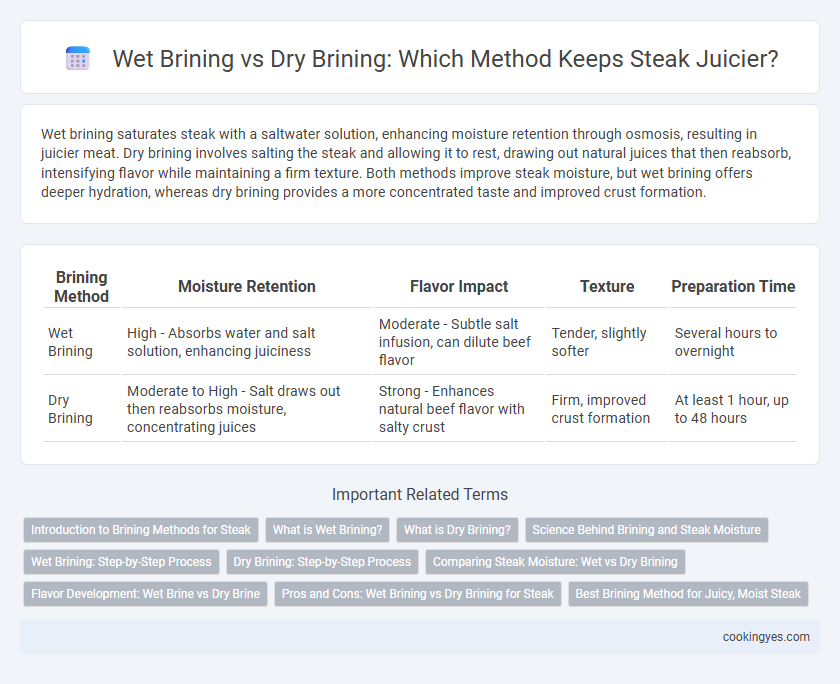Wet brining saturates steak with a saltwater solution, enhancing moisture retention through osmosis, resulting in juicier meat. Dry brining involves salting the steak and allowing it to rest, drawing out natural juices that then reabsorb, intensifying flavor while maintaining a firm texture. Both methods improve steak moisture, but wet brining offers deeper hydration, whereas dry brining provides a more concentrated taste and improved crust formation.
Table of Comparison
| Brining Method | Moisture Retention | Flavor Impact | Texture | Preparation Time |
|---|---|---|---|---|
| Wet Brining | High - Absorbs water and salt solution, enhancing juiciness | Moderate - Subtle salt infusion, can dilute beef flavor | Tender, slightly softer | Several hours to overnight |
| Dry Brining | Moderate to High - Salt draws out then reabsorbs moisture, concentrating juices | Strong - Enhances natural beef flavor with salty crust | Firm, improved crust formation | At least 1 hour, up to 48 hours |
Introduction to Brining Methods for Steak
Wet brining involves soaking steak in a saltwater solution, which enhances moisture retention by allowing the meat to absorb water and salt, resulting in juicier texture. Dry brining uses coarse salt applied directly to the steak's surface, drawing out juices that then reabsorb, intensifying flavor and improving tenderness without added liquid. Both methods optimize steak moisture by manipulating salt's interaction with muscle proteins to retain water during cooking.
What is Wet Brining?
Wet brining involves soaking steak in a saltwater solution, which helps the meat absorb moisture and enhances juiciness during cooking. The salt in the brine breaks down muscle proteins, allowing the steak to retain more water and stay tender. This method is particularly effective for lean cuts, ensuring a moist and flavorful result.
What is Dry Brining?
Dry brining involves seasoning steak with salt and allowing it to rest uncovered in the refrigerator, enabling the salt to penetrate the meat and retain moisture. This method enhances steak tenderness and intensifies natural flavors by promoting protein breakdown and better water retention. Compared to wet brining, dry brining results in a more concentrated beef flavor and a superior crust when cooked.
Science Behind Brining and Steak Moisture
Wet brining increases steak moisture by submerging the meat in a saltwater solution, allowing salt to penetrate and denature muscle proteins, which enhances water retention through protein restructuring. Dry brining applies salt directly to the steak's surface, drawing out moisture that then reabsorbs along with dissolved salt, improving flavor concentration and moisture retention due to osmotic balance and protein interaction. Scientific studies show both methods improve juiciness by altering protein structures and water-binding capacity, but dry brining often results in a more intense flavor profile and firmer texture due to reduced dilution.
Wet Brining: Step-by-Step Process
Wet brining steak involves submerging the meat in a saltwater solution, typically composed of water, kosher salt, and optional aromatics like garlic and herbs, for a period ranging from 30 minutes to several hours depending on steak thickness. The salt penetrates the muscle fibers, enhancing moisture retention and flavor by allowing the steak to absorb and hold onto water during cooking. After soaking, the steak is removed, patted dry to ensure a good sear, and cooked as desired, resulting in a juicier, tender texture.
Dry Brining: Step-by-Step Process
Dry brining steak involves sprinkling salt evenly over the meat's surface and allowing it to rest uncovered in the refrigerator for 1 to 3 days, enhancing moisture retention and flavor through osmotic absorption. During this period, the salt initially draws out the steak's natural juices, which then reabsorb, breaking down muscle proteins to improve tenderness and juiciness. This method intensifies the beef's flavor and promotes a crispy, well-seasoned crust when cooked, making dry brining a preferred choice for achieving optimum steak moisture and taste.
Comparing Steak Moisture: Wet vs Dry Brining
Wet brining enhances steak moisture by submerging meat in a saltwater solution, allowing the muscle fibers to absorb water and retain juiciness during cooking. Dry brining relies on applying salt directly to the steak's surface, which draws out moisture initially but then reabsorbs it, concentrating flavors while maintaining a tender, juicy texture. Studies reveal that while wet brining increases overall water content, dry brining produces a more flavorful steak with a firmer crust and comparable moisture retention.
Flavor Development: Wet Brine vs Dry Brine
Wet brining steak involves soaking the meat in a saltwater solution, which enhances moisture retention and infuses subtle juiciness but can slightly dilute the beef's natural flavors. Dry brining uses salt applied directly to the steak's surface, drawing out moisture that reabsorbs to concentrate and intensify the meat's savory taste and improve crust formation during cooking. Flavor development in dry brined steaks is often preferred by chefs seeking a robust, caramelized crust and deeper umami complexity compared to the milder profile from wet brining.
Pros and Cons: Wet Brining vs Dry Brining for Steak
Wet brining enhances steak moisture by allowing salt to penetrate deeply, ensuring juiciness but can result in a slightly softer texture and longer prep time. Dry brining concentrates flavors by drawing moisture to the surface, improving crust development and tenderness while requiring less space and simpler cleanup but may risk uneven seasoning if not monitored. Both methods improve steak moisture retention; choice depends on desired flavor intensity and texture preference.
Best Brining Method for Juicy, Moist Steak
Wet brining steak involves soaking it in a saltwater solution, which enhances moisture by allowing the meat to absorb water and salt, resulting in a juicier texture. Dry brining uses coarse salt applied directly on the steak's surface, drawing out moisture that then reabsorbs, intensifying the steak's natural flavors while maintaining a firm, succulent bite. For the juiciest, moist steak, dry brining is often preferred due to its ability to concentrate flavor and improve texture without excess water retention.
Wet Brining vs Dry Brining for Steak Moisture Infographic

 cookingyes.com
cookingyes.com